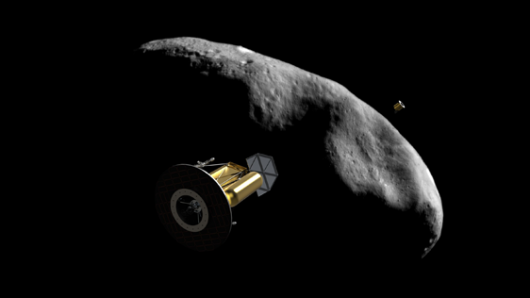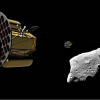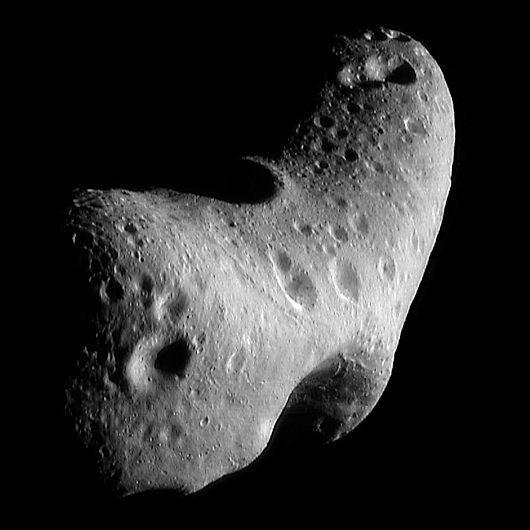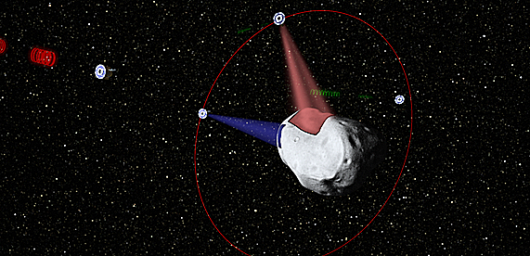Grand plans for asteroid mining unveiled by Planetary Resources
By Brian Dodson
17:16 April 25, 2012
“I’m Chris Lewicki, and I’m an asteroid miner!” These were the opening words spoken by the President and Chief Engineer of Planetary Resources Inc., as the asteroid mining company emerged from three years of silent running to outline its plans to begin mining Near-Earth Asteroids (NEAs) within the decade.
Asteroid mining has been a standard of science fiction since E.E. Smith’s Lensman series was published in the 1930s. Planetary Resources (PRI - previously known as Arkyd Astronautics), a start-up company with high-profile backers and strong technical depth, announced its space mining plans at a press conference on Tuesday. Its goal, as expressed by co-founder and co-chairman Peter Diamandis, is to "make the resources of space available to humanity."
The following video outlines why and how PRI intends to mine the asteroids.
The whys of asteroid mining
“Many of the scarce metals and minerals on Earth are in near-infinite quantities in space. As access to these materials increases, not only will the cost of everything from microelectronics to energy storage be reduced, but new applications for these abundant elements will result in important and novel applications,” said Peter H. Diamandis, M.D., Co-Founder and Co-Chairman of PRI.
The north polar region of near-Earth asteroid 433 Eros as imaged by the NEAR Shoemaker probe (Image: NASA)
The prize in asteroid mining? Huge amounts of raw materials, ranging from water to precious metals, and transition from an economy of scarcity to an economy of abundance. Most asteroids are rich in precious metals, such as platinum, gold, iridium, osmium, palladium, rhodium, and ruthenium - far richer than terrestrial ores. Indeed, the precious metals for which we mine on Earth were the result of ancient asteroid impacts - we have, in effect, been mining asteroids for thousands of years.
Whereas a terrestrial platinum ore may have a concentration of 0.5 parts per million (ppm), the concentration in an asteroid can be as large as 100 ppm, with a total precious metals concentration of 350 ppm. Such an asteroid also contains about 6 ppm of rare earth compounds, for which industry and consumers both are feeling the effects of scarcity. To have rich ore greatly simplifies the extraction process.
To illustrate the potential of mining asteroids for precious metals, the Lavender Pit is a relatively small open pit copper mine near Bisbee, AZ, USA. In 25 years it grew to a volume of 0.33 cubic kilometers, in the process removing 340 million tons of ore, yielding 600,000 tons of copper worth about US$5 billion at today’s prices.
An asteroid about 850 meters in diameter has the same volume, but contains eight hundred thousand tons of precious metals worth about US$50 trillion. It would supply precious metals at the current worldwide rate of production for 40 years . There are about a million asteroids of this size in the Solar System, and perhaps 10-20% of them will yield precious metals in this amount. Asteroids thus provide rich ore for precious metals having a total present value of about 5 quintillion US dollars. The tailings, of course, form a cheap space-based source of building material.
Now, what about water? Water is cheap, after all – a liter of bottled water costs about half a US dollar. However, in space it is a valuable commodity, as it costs about US$20,000 per liter to boost water into low earth orbit (LEO). This presents both manned and robotic spaceflight with a problem.
Astronauts are people, too, and they need water – at least four to five liters a day even in a prolonged emergency situation. Currently, it costs about a million US dollars per day to keep an astronaut in orbit. The International Space Station budget for consumables allows for about 30 kg/day/astronaut – costing six hundred thousand US dollars to lift into orbit daily supplies for one astronaut. When all factors are taken into account (there are additional regular losses), most of the cost of manned spaceflight is the cost of taking along consumables.
An inexpensive space-based source of water would greatly enhance our ability to tackle manned and unmanned space missions. Of course, when you have water and sunlight, you can make oxygen and hydrogen gas. Not only do we breathe oxygen, but oxygen and hydrogen is the chemical rocket propellant having the highest known performance. Fuel costs that same US$20,000 per kilogram to lift into LEO, so a cheap source of water in space is also a cheap source of fuel – enough fuel to explore the Solar System.
Asteroids similar to carbonaceous chondrite meteorites contain as much as 20% water, which can be released with very mild heating. A carbonaceous chondrite asteroid only 10 meters (32.8 ft) in diameter can contain 120 tons of water, with a present value in LEO of 2.4 billion US dollars. Converted into fuel, this amount of water would fill six Centaur interplanetary boosters like that used to propel the Cassini-Huygens mission to Saturn and Titan. Not bad for what could be the first mined asteroid!
The hows of asteroid mining
Planetary Resources intends to make asteroid mining a reality be developing cost-effective, mass produced robotic exploration and extraction technologies. This will position the company to efficiently target resource-rich asteroids and extract their useful raw materials.
Of the approximately 9,000 known NEAs, there are more than 1,500 that are energetically as easy to reach as the Moon – 4,000 if the energy required to return refined materials to the Earth is included in the comparison. This is a rich target environment, in which the capability to characterize NEAs using robotic probes is crucial for PRI’s current vision. To that end, PRI has developed the first in its planned line of deep-space prospecting spacecraft.
An Arkyd-101 space telescope in low Earth orbit
The Arkyd-100 series of orbital spacecraft comprises LEO satellites containing small-scale space telescopes. The first of these is the Arkyd-101, a tiny spacecraft only measuring about 16”x16”x40” (40x40x100 cm) in size, containing a remote imaging telescope with a 9” (22 cm) aperture and sub-arcsecond resolution capability. These will be placed in low-Earth orbit by hitching a ride with other satellites being placed in orbit.
The purpose of the Arkyd-100 series is to discover and prioritize NEA mining candidates for more detailed inspection, but they will also provide commercial Earth imaging and educational space telescope services. The number of Arkyd-100 series to be placed in orbit initially has not been announced, but the first launch is scheduled for late 2013.
The Arkyd-200 series (Interceptors) are essentially Arkyd-100 series spacecraft to which are added the propulsive means needed to go out and closely study asteroids on near-earth orbits. They will be used for closer examination of promising NEAs, and will have conventional and multispectral imaging capability, perhaps with electronic sensors such as radar and/or magnetic field measuring capability.
A swarm of Arkyd-300 series rendezvous probes examining a candidate asteroid
Later in the decade, the Arkyd-300 series will help finalize the selection process. Arkyd-300 rendezvous prospectors will be sent in swarms to rendezvous with and examine particular asteroids. The swarm will include assorted members of the Arkyd-300 series which provide complementary information about a target asteroid. Multiple asteroids can be examined by a single swarm, and the spacecraft can be recovered and reused.
Actual mining operations will start with extraction of water from suitable asteroids. If you have water, you have the resources to enable large-scale exploration of the Solar System.
Recovery and processing of materials in a microgravity environment will require significant research and development activity. PRI is committed to take on the creation of in-situ extraction and processing technologies to provide access to both asteroidal water and metals. When combined with PRI’s mass produced deep space explorers, the result will be a new resource for humanity – the capability to undertake the sustainable development of space.
The broader vision, however, will be served even if asteroid mining itself is a failure. “The promise of Planetary Resources is to apply commercial innovation to space exploration," said Tom Jones, Ph.D., veteran NASA astronaut, planetary scientist and PRI advisor. "They are developing cost-effective, production-line spacecraft that will visit near-Earth asteroids in rapid succession, increasing our scientific knowledge of these bodies and enabling the economic development of the resources they contain.” The new technologies being developed by PRI will set the stage for Solar System discovery and economic development over the next century.
PRI was founded in 2009, and is financed by visionaries who have launched whole industries which did not previously exist. These include:- Erik Anderson – Co-Founder and Co-Chairman of PRI, Mr. Anderson is an entrepreneur and aerospace engineer who is associated with Intentional Software Corporation, Space Adventures, and Planetary Power.
- Peter Diamandis, M.D. – Co-Founder and Co-Chairman of PRI, Dr, Diamandis is an international pioneer in the development of the commercial space sector. He is Chairman and CEO of the X PRIZE Foundation, and the Executive Chairman of Singularity University.
- Rena Shulsky David – President and CEO of Shire Realty in New York City, Ms. David founded and chaired the “Swords into Plowshares” meeting between US and Soviet military officers as the Soviet Bloc was collapsing.
- Larry Page – Computer scientist and internet entrepreneur, Mr. Page is Co-Founder and CEO of Google, and an investor in other forward-looking technology companies.
- Ross Perot, Jr. – Real estate developer and Chairman of Perot Systems, Mr. Perot piloted the first round-the-world helicopter flight.
- Raymie Stata – entrepreneur and former CTO of Yahoo!
- Eric Schmidt, Ph.D. – Software engineer, businessman, and Executive Chairman of Google is also a well-known art collector and was considered by President Obama for the position of Commerce Secretary.
- K. Ram Shriram - Google investor and Board of Directors founding member.
- Charles Simonyi, Ph.D. - Intentional Software Co-founder and two-time space tourist (time in space, 26 days 14 hours), at Microsoft he was responsible for developing Word and Excel.
- John C. Whitehead – Former Chairman and CEO of Goldman Sachs, former Chairman of the Board of the Federal Reserve Bank of New York, and 9th Deputy Secretary of State for President Reagan.
Some of the company’s advisors include film maker and explorer James Cameron; General T. Michael Moseley (Ret.); Sara Seager, Ph.D.; Mark Sykes, Ph.D.; and David Vaskevitch.
Source: Planetary Resources, Inc.






